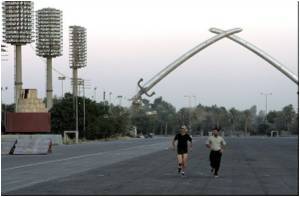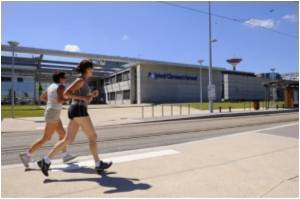The classic scientific view that conserving energy maximizes performance in a sprinting event has been challenged by a new study.

"That prevailing view is no longer viable. Sprinters, if anything, are wasteful of energy. This is due to the biological trade-offs between faster muscle fibers that provide the large and rapid forces needed for sprinting, and slower muscle fibers that maximize metabolic economy," said Matthew W. Bundle at the University of Montana, who conducted the study with Peter G. Weyand at Southern Methodist University, Dallas.
Instead, the key to top-flight sprinting is to maximize how hard each foot hits the ground, which allows sprinters to translate musculoskeletal and ground reaction forces into swift motion, said Bundle.
"Saving energy is critically important for endurance, but not for sprinting, which our findings indicate is not energy-limited," Bundle said.
Metabolic energy available from sustainable, aerobic sources predominantly determines performance during endurance events by setting the intensity of the musculoskeletal performance that can be sustained throughout the effort, the study found.
For sprinters, Bundle and Weyand concluded the opposite is true.
Advertisement
To analyze the mechanics of burst-type sprint activities, the researchers said they drew on all-out running speeds and cycling power outputs of humans because of the abundance and quality of the data available and because the mechanical and metabolic contrasts between the two provide informative insights. The researchers focused on durations of up to five minutes, particularly on efforts of less than a minute.
Advertisement
More rapid increases were typical for the briefest trials that required the greatest forces. That indicates that all-out sprinting performances are highly dependent on duration because of the speed of musculoskeletal fatigue during dynamic exercise requiring large force outputs, the researchers reported.
Sprint performance linked to mechanics of applying external forceundle and Weyand altered three independent variables to maximize the variation observed in sprint performance: Subjects were individuals with large differences in their sprint performance capabilities; all-out sprint trials spanned a broad range of durations from 2 to 300 seconds; and performance was compared across different modes of sprinting, namely cycling and running.
"The predictive success of our force application model, both within and across modes of sprint exercise, indicates that as efforts extend from a few seconds to a few minutes, the fractional reliance on anaerobic metabolism progressively impairs whole-body musculoskeletal performance, and does so with a rapid and remarkably consistent time course," the researchers wrote.
"In this respect, the sprint portion of the performance-duration curve predominantly represents, not a limit on the rates of energy re-supply, but the progressive impairment of skeletal muscle force production that results from a reliance on anaerobic metabolism to fuel intense, sequential contractions," they concluded.
The findings appeared in the July issue of Exercise and Sport Sciences Reviews.
Source-ANI












